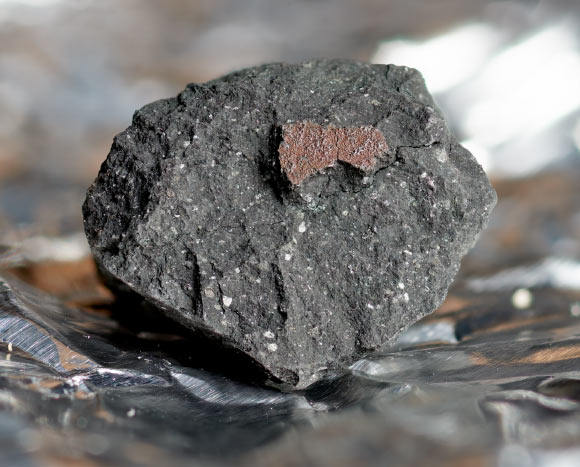Almost 300 g of the so-called Winchcombe meteorite, a space rock that fell from the fireball that lit up the sky over the United Kingdom and Northern Europe on February 28, 2021, have been located in Winchcombe, Gloucestershire, the United Kingdom.

A fragment of the Winchcombe meteorite. Image credit: Trustees of the Natural History Museum, London.
There are approximately 65,000 known meteorites on Earth. Only 1,206 have been witnessed to fall and of these only 51 are carbonaceous chondrites.
Carbonaceous chondrites are made of a mixture of minerals and organic compounds, including amino acids.
They are the most primitive and pristine materials of the Solar System and can provide unique information on where water and the building blocks of life were formed and what planets are made from.
The Winchcombe meteorite is the first known carbonaceous chondrite to have been found in the United Kingdom, and the first meteorite recovered in the United Kingdom in 30 years.
“It’s thanks to this international collaboration, including researchers as far away as Australia, that we were able to calculate where this meteorite landed so quickly and with such accuracy, as well as where it originated from in the asteroid belt,” said Dr. Luke Daly, a researcher at the University of Glasgow who co-leads the UK Fireball Network, part of UKFAll and the Global Fireball Observatory.
Although the meteorite blazed through our atmosphere at 14 km per second, its interior remained cold and unchanged.
Because it was recovered so quickly it also escaped damage by rain and weather, which can quickly render a meteorite far more complicated to analyze.
“Nearly all meteorites come to us from asteroids, the leftover building blocks of the Solar System that can tell us how planets like the Earth formed,” said Dr. Ashley King, a researcher in the Department of Earth Sciences at the Natural History Museum, London.
“The opportunity to be one of the first people to see and study a meteorite that was recovered almost immediately after falling is a dream come true!”
“I was in shock when I saw it and immediately knew it was a rare meteorite and a totally unique event,” said Dr. Richard Greenwood, a planetary researcher at the Open University.
“It’s emotional being the first one to confirm to the people standing in front of you that the thud they heard on their driveway overnight is in fact the real thing.”
“JAXA’s Hayabusa-2 mission returned around 4.5 g of fragments from asteroid Ryugu to Earth in December 2020, and we are helping to characterize this material,” said Professor Sara Russell, a researcher at the Natural History Museum, London.
“The Winchcombe meteorite fall is very timely as the rock is similar to Ryugu in many ways, and we can use the meteorite to rehearse for mission analyses.”
“It’s amazing! The meteorite was retrieved so soon after its fall and in such pristine condition that it’s almost like a sample returned from a space mission,” said Professor Gareth Collins, a planetary scientist in the Department of Earth Science and Engineering at Imperial College London.
“With the added value of a known orbit allowing us to pin down where this space rock came from, the United Kingdom has in a way just had its own natural asteroid sample return mission.”
“Studying such rocks can provide unique information on where water and the building blocks of life were formed, and what planets are made from — some of the biggest questions asked by the scientific community,” said Dr. Matt Genge, also from the Department of Earth Science and Engineering at Imperial College London.
“It’s also fascinating that much of it fell to bits as dust, since it shows how these weak asteroids behave, and explains why dust from these objects continually falls through our atmosphere.”
_____
This article is based on press-releases provided by the Natural History Museum, London, and Imperial College London.







